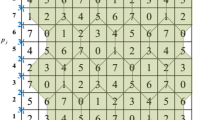Abstract
Data embedding is a technique for embedding secret information into the carrier data, such as text, audios, images, and videos. Meanwhile, it also can ensure that the changes in the carrier data are imperceptible by human eye to avoid attracting the attention of malicious attackers. In this paper, we propose a data embedding scheme based on the multi-matrix structure of turtle shell (MMS-TDH). First, weighting is introduced to divide the cover image into various regions, i.e., a smooth region, a texture region and an edge region. Second, considering that the human eye is more sensitive to changes in the pixels in the smooth region than in the other regions, the smaller turtle shell matrix was used to ensure fewer changes in the pixels of the smooth region, and the larger turtle shell matrix was used for the edge region to improve the embedding capacity. This process ensures the flexibility of our scheme in balancing embedding capacity and image quality, and it also avoids the sharp decline in image quality when the turtle shell matrix enlarges. Extensive experimental results validated the expected merits of the proposed scheme.







Similar content being viewed by others
References
Abul-Kasim H (2012) Data hiding by lsb substitution using gene expression programming. Int J Comput Appl (45):13–20
Aljuaid N, Gutub A, Khan E (2015) Stego-system for hiding text in images of personal computers, Proceeding of the 12th Learning and Technology Conference: Wearable Tech/wearable Learning, Effat University
Ou B, Li X, Zhao Y, Ni R, Shi YQ (2013) Pairwise prediction-error expansion for efficient reversible data hiding. IEEE T Image Process 22(12):5010–5021
Chang CC, Liu Y, Nguyen TS (2014) A novel turtle shell based scheme for data hiding. Tenth International Conference on Intelligent Information Hiding and Multimedia Signal Processing, p 89–93
Chen J (2014) A PVD-based data hiding method with histogram preserving using pixel pair matching. Signal Process Image Commun 29(3):375–384
Chen TH, Lin KS, Lin CH (2017) On the design of a two-decoding-option image secret sharing scheme. Multimed Tools Appl:1–17
Davis M (1978) The data encryption standard in perspective. IEEE Communication Society Magazine 16(6):5–9
Elsheh E, Hamza AB (2011) Secret sharing approaches for 3D object encryption. Expert Syst Appl 38(11):13906–13911
Fridrich J, Goljan M, Du R (2002) Reliable detection of lsb steganography in color and grayscale images. Proceedings of the 2001 Workshop on Multimedia & Security: New Challenges 8:22–28
Gutub AA (2010) Pixel Indicator technique for RGB image steganography. Journal of Emerging Technologies in Web Intelligence 2(1):56–64
Jiang N, Zhao N, Wang L (2016) LSB based quantum image steganography algorithm. Int J Theor Phys 55(1):107–123
Kieu TD, Chang CC (2011) A steganographic scheme by fully exploiting modification directions. Expert Syst Appl 38(8):10648–10657
Kim C (2014) Data hiding by an improved exploiting modification direction. Multimedia Tools and Applications 69(3):569–584
Kim C, Yang CN (2016) Data hiding based on overlapped pixels using hamming code. Multimed Tools Appl 75(23):15651–15663
Kim HJ, Kim C, Choi Y, Wang S, Zhang X (2010) Improved modification direction methods. Comput Math Appl 60(2):319–325
Lee CF, Chang CC, Pai PY, Liu CM (2015) Adjustment hiding method based on exploiting modification direction. Int J Netw Secur 17(5):607–618
Lin YK (2012) High capacity reversible data hiding scheme based upon discrete cosine transformation. J Syst Softw 85(10):2395–2404
Liu Y, Chang CC, Nguyen TS (2016) High capacity turtle shell-based data hiding. IET Image Process 10(2):130–137
Liu L, Chang CC, Wang A (2016) Data hiding based on extended turtle shell matrix construction method. Multimed Tools Appl 76(10):1–18
Luo W, Huang F, Huang J (2010) Edge adaptive image steganography based on lsb matching revisited. IEEE T Inf Foren Sec 5(2):201–214
Mali SN, Patil PM, Jalnekar RM (2012) Robust and secured image-adaptive data hiding. Digit Signal Process 22(2):314–323
Mielikainen J (2006) Lsb matching revisited. IEEE Signal Proc Let 13(5):285–287
Parvez MT, Adnan A, Gutub AA (2011) Vibrant color image steganography using channel differences and secret data distribution. Kuwait Journal Ofence & Engineering 38(1):127–142
Shen SY, Huang LH (2015) A data hiding scheme using pixel value differencing and improving exploiting modification directions. Comput Secur 48:131–141
Shen SY, Huang LH, Yu SS (2017) A novel adaptive data hiding based on improved EMD and interpolation. Multimed Tools Appl 1:1–17
Wang Z, Bovik AC, Sheikh HR, Simoncelli EP (2004) Image quality assessment: from error visibility to structural similarity. IEEE Trans Image Process 13(4):600–614
Zhang X, Wang S (2006) Efficient steganographic embedding by exploiting modification direction. IEEE Commun Lett 10(11):781–783
Acknowledgements
This work was supported in part by The National Natural Science Foundation of China (No.61540009).
Author information
Authors and Affiliations
Corresponding authors
Additional information
Publisher’s Note
Springer Nature remains neutral with regard to jurisdictional claims in published maps and institutional affiliations.
Rights and permissions
About this article
Cite this article
Liu, L., Wang, L. & Chang, Cc. Data embedding scheme based on multi-matrix structure of turtle shell to avoid human eye perception. Multimed Tools Appl 78, 10473–10490 (2019). https://doi.org/10.1007/s11042-018-6606-0
Received:
Revised:
Accepted:
Published:
Issue Date:
DOI: https://doi.org/10.1007/s11042-018-6606-0




